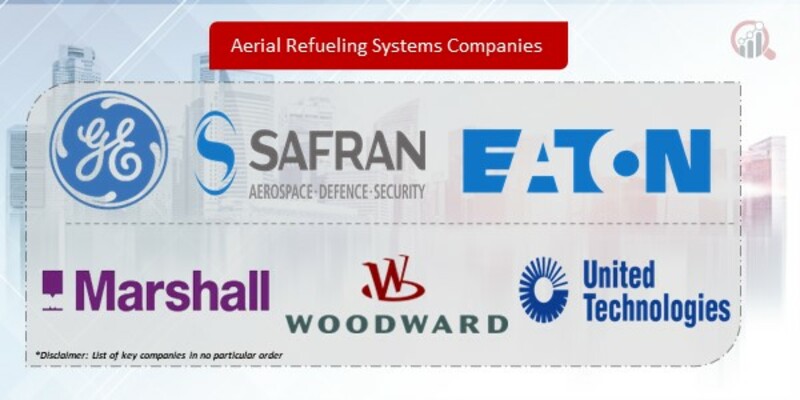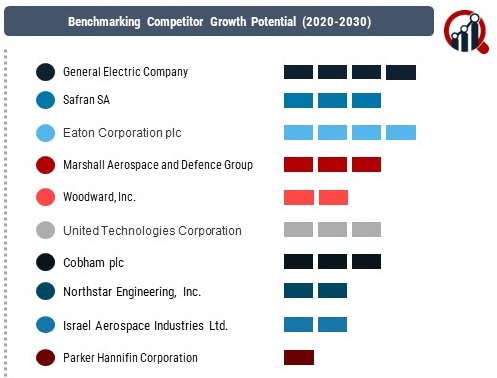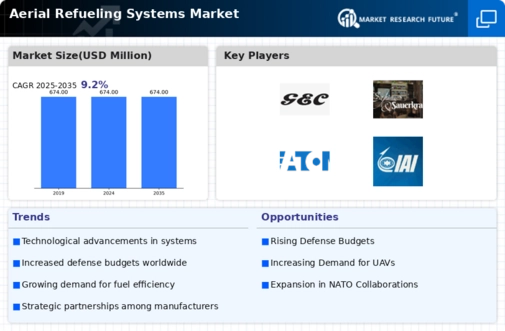Top Industry Leaders in the Aerial Refueling Systems Market

Key Players
General Electric Company (US),
Safran SA (France),
Eaton Corporation plc (Ireland),
Marshall Aerospace and Defence Group (UK),
Woodward, Inc. (US),
United Technologies Corporation (US),
Cobham plc (UK),
Northstar Engineering, Inc. (US),
Israel Aerospace Industries Ltd. (Israel),
Parker Hannifin Corporation (US).
Strategies Adopted
Surviving and thriving in the Aerial Refueling Systems market demands strategic agility. Key players adopt multifaceted approaches to maintain a competitive edge. Technological innovation remains a cornerstone, with companies investing heavily in research and development to enhance the efficiency, safety, and capabilities of their aerial refueling systems. Boeing, for instance, continues to refine its tanker offerings, integrating state-of-the-art avionics and automation systems.
Strategic partnerships and collaborations are prevalent strategies as well. Lockheed Martin's partnership with the U.S. Marine Corps for the development and deployment of the CH-53K King Stallion showcases the importance of aligning with military requirements. Additionally, alliances with other aerospace and defense companies for joint ventures and technology sharing contribute to the overall strength of key players in the market.
Factors for Market Share Analysis
Several factors play a crucial role in determining market share within the Aerial Refueling Systems segment. The technological prowess of a company's offerings, including the capability to refuel different types of aircraft in various mission scenarios, is a significant factor. Versatility and adaptability of the systems to meet evolving defense requirements contribute to market leadership.
Long-term contracts and partnerships with military organizations worldwide also influence market share. Companies that secure substantial contracts for the supply, maintenance, and upgrade of aerial refueling systems enjoy a competitive advantage. The ability to provide comprehensive solutions, including training and logistical support, adds another layer to market share dynamics. Moreover, reliability and safety are paramount considerations, as military operators prioritize systems with a proven track record in demanding operational environments.
New and Emerging Companies
While established players dominate the Aerial Refueling Systems market, the emergence of new companies brings fresh perspectives and innovative solutions to the table. Emerging players often focus on niche segments or introduce disruptive technologies. For instance, Omega Air, a relatively newer entrant, specializes in air-to-air refueling services using modified commercial aircraft. These nimble companies challenge traditional norms and provide alternative solutions that resonate with evolving defense needs.
Start-ups in the aerial refueling space are exploring novel approaches, such as autonomous refueling technologies and adaptive systems that can cater to a broader range of aircraft. As military requirements evolve, these emerging companies play a pivotal role in injecting innovation and fostering healthy competition within the market.
Industry News
Staying abreast of industry news is imperative in understanding the dynamic landscape of Aerial Refueling Systems. Recent developments include the integration of advanced communication and navigation systems to enhance the accuracy and speed of refueling operations. Additionally, there is a growing focus on the development of unmanned aerial refueling capabilities, exploring the potential for autonomous systems to refuel manned aircraft in challenging environments.
Industry news also reflects geopolitical influences, such as defense budget allocations and strategic partnerships between nations. The opening of new markets and collaborations for joint development projects signal shifts in the global landscape, impacting the competitive dynamics of the Aerial Refueling Systems market.
Current Company Investment Trends
Investment trends in the Aerial Refueling Systems market underline the commitment of key players to innovation and market leadership. Research and development continue to be a focal point, with investments directed toward improving fuel transfer technologies, enhancing connectivity, and exploring new materials to reduce weight and increase efficiency. Boeing's ongoing investment in the KC-46 tanker program exemplifies the industry's dedication to refining existing systems.
Additionally, there is a discernible trend toward sustainability and fuel efficiency, with companies exploring technologies to minimize the environmental impact of aerial refueling operations. The integration of advanced materials and propulsion systems that reduce fuel consumption is a notable area of investment. As governments worldwide prioritize eco-friendly defense solutions, companies are aligning their strategies to meet these evolving expectations.
Overall Competitive Scenario
The Aerial Refueling Systems market presents a dynamic landscape characterized by the technological prowess of established players, the innovation brought by emerging companies, and ongoing investment trends shaping the future of aerial refueling. Key players deploy strategies encompassing technological innovation, strategic partnerships, and a focus on reliability and safety to maintain their dominance.
The factors influencing market share, including technological capabilities, long-term contracts, and global collaborations, underscore the multifaceted nature of competition within this niche market. The emergence of new companies injects vitality and innovation, challenging industry norms and offering alternative solutions. Industry news reflects the ever-evolving nature of defense requirements, while current investment trends emphasize the industry's commitment to advancing technologies, sustainability, and meeting the challenges of modern warfare.
As the Aerial Refueling Systems market continues to evolve, companies that navigate these complexities, adapt to emerging trends, and prioritize innovation and strategic partnerships are likely to soar to new heights in this competitive and strategically significant segment of the aerospace and defense industry.
Recent News
Cobham Plc (COB)
Despite undergoing acquisition by Eaton Corporation, remains a key player with their industry-leading refueling systems and technology, used by various military forces globally.
Focuses on enhancing the performance and reliability of existing systems
Boeing (BA)
Successfully achieved the first flight of the MQ-25 T1 tanker drone with an Aerial Refueling Store (ARS), signifying a major milestone in the U.S. Navy's next-generation refueling program.
Partnered with the Australian Defence Force to explore advanced refueling technologies and potential collaboration on future aerial refueling systems.











